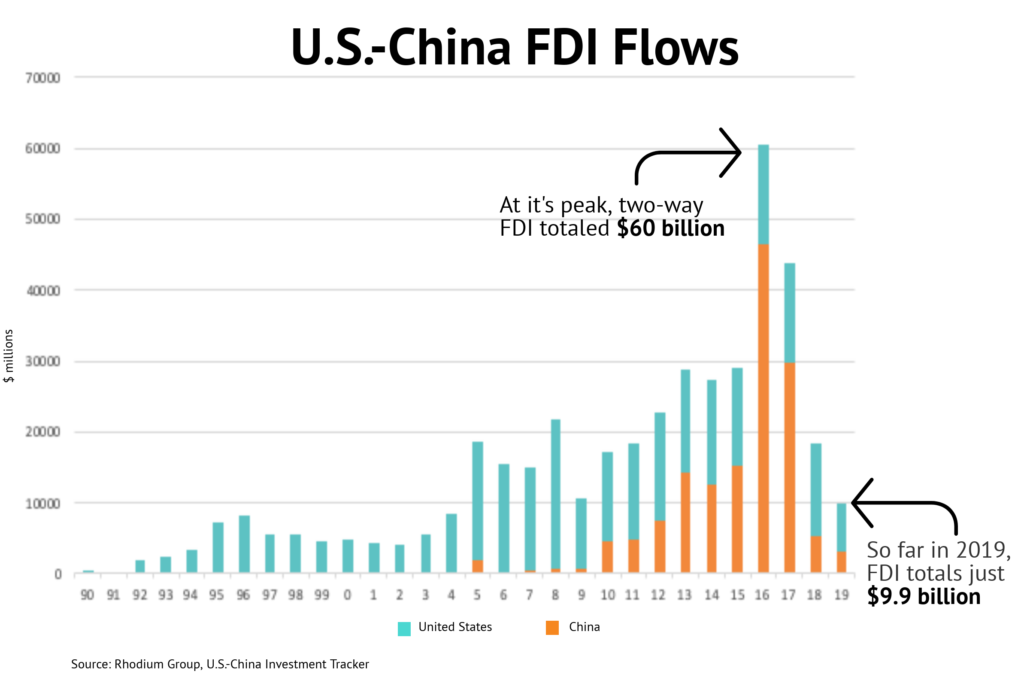Published 23 August 2019
As the trade war rages, US-China FDI is plummeting. But venture capital investment is becoming an increasingly bigger piece of the investment puzzle.
Two-way FDI is plummeting
With trade talks between the United States and China running hot and cold, it’s irresistible to get sucked into daily US-China trade war updates with its unexpected tariff announcements. In the bigger picture, the underlying uncertainty caused by ongoing trade tensions between the United States and China is having a large impact, particularly on two-way foreign direct investment (FDI).
So far this year, combined two-way US and Chinese FDI has totaled just US$9.9 billion — its lowest six-month value in five years, according to research firm Rhodium Group. At its peak in 2016, combined FDI totaled over US$60 billion a year.
The slow start in 2019 is a continuation of a rough year for FDI in 2018, when flows between the United States and China dropped 60 percent year-over-year. Rhodium Group cites a deteriorating political relationship and regulatory intervention as two big reasons for the sharp decrease in investment.
US-China FDI troubles are part of a bigger trend happening across the world, as global foreign investment flows fell to their lowest levels since the financial crisis in 2018, according to UNCTAD. Global FDI flows totaled US$1.2 trillion in 2018 – down 20 percent from 2017.

Invested in each other
With trade tensions rising to a fever pitch, it may be hard to remember that American and Chinese companies have invested a lot in each other’s success over the last 30 years – over US$420 billion, to be exact. US FDI in Chinese industries adds up to over US$275 billion since 1990. While Chinese investment in the United States is almost half of that at US$148 billion, according to Rhodium Group’s US-China investment tracker.

Beyond the sheer volume of money invested, foreign companies bring much more intangible value to the table. In his book, “Developing China: The Remarkable Impact of Foreign Direct Investment,” Michael Enright used an economic impact analysis to better understand the full impact of FDI in China. Enright estimates that foreign companies have contributed as much as one-third of China’s GDP and 27 percent of China’s employment through the accumulated impact of their investments, operations and supply chains in China. American companies alone contributed 4.2 percent of China’s GDP and nearly three percent of Chinese employment in 2014, according to Enright’s analysis.
Enright also pointed out that foreign companies have helped China develop by creating suppliers and distributors, introducing modern technologies, improving business practices, modernizing management training, improving sustainability performance, and helping to shape China’s legal and regulatory systems.
Chinese companies operating in the United States also bring benefits. As the second-fastest growing source of FDI in the United States in 2016, Chinese-owned firms supported nearly 80,000 US jobs, invested nearly US$600 million in innovative R&D, and expanded US exports by US$4.7 billion in 2016, according to Select USA.
Growing regulatory hurdles
The ongoing U.S.-China trade war is not entirely to blame for the recent dive in FDI. Both nations have stepped up regulatory oversight of foreign investment in recent years. Following the 2016 peak of global outbound investment by Chinese firms, the Chinese government tightened its grip on outbound capital flows, drastically slowing outbound investment by Chinese firms.
In the United States, the Committee on Foreign Investment in the United States (CFIUS) has stepped up investment screening of Chinese FDI, especially in sectors related to national security like infrastructure and information and communications technologies. Rhodium Group estimates US$2.5 billion was left on the table in 2018, as Chinese investors abandoned deals in the United States due to unresolved CFIUS concerns.
The US investment landscape may get more complicated for Chinese companies to navigate in the near future, as investors await the implementation of the new Foreign Investment Risk Review Modernization Act (FIRRMA) and Export Control Reform Act (ECRA), both expected to increase US regulatory oversight of foreign investments.
Foreign direct investment by American companies in China has also decreased, but not as drastically as for its Chinese counterparts. Yet, concerns about technology leakage have led to a cooling in US FDI in China’s technology sectors.
FDI cooling, venture capital heating up
At the same time FDI is slowing, venture capital investment is becoming an increasingly bigger piece of the US-China investment puzzle.
Chinese VC investment in the United States has increased dramatically since 2014, with Chinese-owned VC funds contributing an estimated US$3.6 billion to US companies over the course of 270 different funding rounds in 2018. This is just a fraction of what US-owned VC firms have spent in China, but an important trend. US VC firms invested a record US$19 billion in Chinese start-up companies last year, according to Rhodium Group.

Firms on both sides of the world have utilized VC investment to invest in companies in sectors where FDI has faced growing regulatory scrutiny. Chinese VC firms have invested in semiconductors, for example, while US VC Firms have invested in sectors limited to foreign firms in China like digital payments and internet start-ups.
Confidence is key
In order for foreign investments to work, companies are dependent on the success and stability of the nations where they choose to invest. Both American and Chinese companies have invested a lot in each other, through decades of foreign direct investment and now growing venture capital investment.
As the US-China trade war rages without an end in sight, it’s worth remembering that ongoing tensions cost more than just tariffs on the products in your shopping cart. They are also a roadblock to long-term investments that bring additional capital, exports and jobs to each other’s economies.
© The Hinrich Foundation. See our website Terms and conditions for our copyright and reprint policy. All statements of fact and the views, conclusions and recommendations expressed in this publication are the sole responsibility of the author(s).





